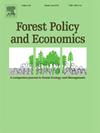Forest dependency and food security: Diverse livelihoods in India's tribal heartland
IF 3.8
2区 农林科学
Q1 ECONOMICS
引用次数: 0
Abstract
Despite the critical role of forests in sustaining livelihoods, knowledge gaps remain regarding the food security of forest-dependent communities. Existing research predominantly emphasizes forest-based livelihoods and agricultural activities for income and subsistence, often neglecting the broader spectrum of livelihood strategies adopted by these communities. This study investigates the relationship between food security and diverse livelihoods, drawing on survey data from 2258 households in tribal-dominant locations across seven Central-Eastern Indian states. Results indicate that 35 % of households experience severe food insecurity, despite significant forest dependence (∼59 %). Our analysis reveals that pluri-active livelihoods—encompassing forest-based income, wages, salaried work, and other income streams—contribute substantially to household income. Logistic regression analysis further highlights key factors associated with lower food insecurity, including higher forest-based and salaried income, greater ownership of durable assets, and reduced reliance on livestock. Additionally, higher food security was linked to households experiencing lower climatic stress and having older, more educated household heads. Non-migrant, literate, and male-headed households were also more likely to achieve food security, highlighting the vulnerabilities faced by women-headed and migrant households. While conducted during the COVID-19 pandemic, these findings have broader implications for policy and research, emphasizing the need to address diverse livelihood needs to enhance the wellbeing of forest-dependent communities.
对森林的依赖和粮食安全:印度部落中心地带的多样化生计
尽管森林在维持生计方面发挥着关键作用,但在依赖森林的社区的粮食安全方面,知识差距仍然存在。现有的研究主要强调以森林为基础的生计和农业活动的收入和生计,往往忽视了这些社区采用的更广泛的生计战略。本研究调查了粮食安全和多样化生计之间的关系,利用了来自印度中东部七个邦的2258户家庭的调查数据。结果表明,尽管严重依赖森林,但仍有35%的家庭(约59%)面临严重的粮食不安全问题。我们的分析表明,多元生计——包括以森林为基础的收入、工资、受薪工作和其他收入来源——对家庭收入有很大贡献。Logistic回归分析进一步强调了与粮食不安全程度降低相关的关键因素,包括提高林源收入和工资性收入、增加对耐用资产的拥有率以及减少对牲畜的依赖。此外,较高的粮食安全水平与气候压力较低、户主年龄较大、受教育程度较高的家庭有关。非移民、有文化和男性户主的家庭也更有可能实现粮食安全,这凸显了女性户主和移民家庭面临的脆弱性。这些调查结果虽然是在2019冠状病毒病大流行期间进行的,但对政策和研究具有更广泛的影响,强调需要解决各种生计需求,以改善依赖森林的社区的福祉。
本文章由计算机程序翻译,如有差异,请以英文原文为准。
求助全文
约1分钟内获得全文
求助全文
来源期刊

Forest Policy and Economics
农林科学-林学
CiteScore
9.00
自引率
7.50%
发文量
148
审稿时长
21.9 weeks
期刊介绍:
Forest Policy and Economics is a leading scientific journal that publishes peer-reviewed policy and economics research relating to forests, forested landscapes, forest-related industries, and other forest-relevant land uses. It also welcomes contributions from other social sciences and humanities perspectives that make clear theoretical, conceptual and methodological contributions to the existing state-of-the-art literature on forests and related land use systems. These disciplines include, but are not limited to, sociology, anthropology, human geography, history, jurisprudence, planning, development studies, and psychology research on forests. Forest Policy and Economics is global in scope and publishes multiple article types of high scientific standard. Acceptance for publication is subject to a double-blind peer-review process.
 求助内容:
求助内容: 应助结果提醒方式:
应助结果提醒方式:


